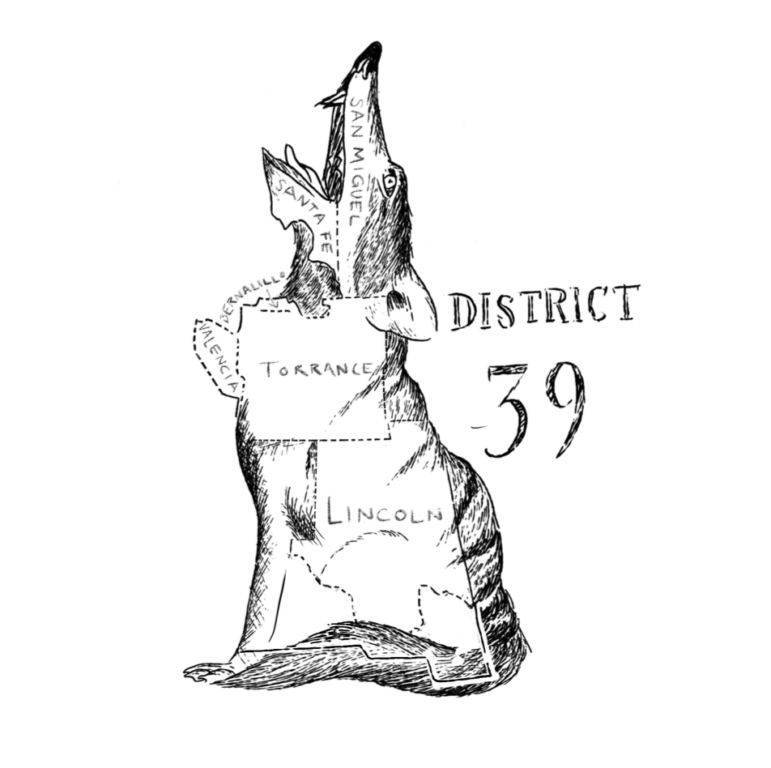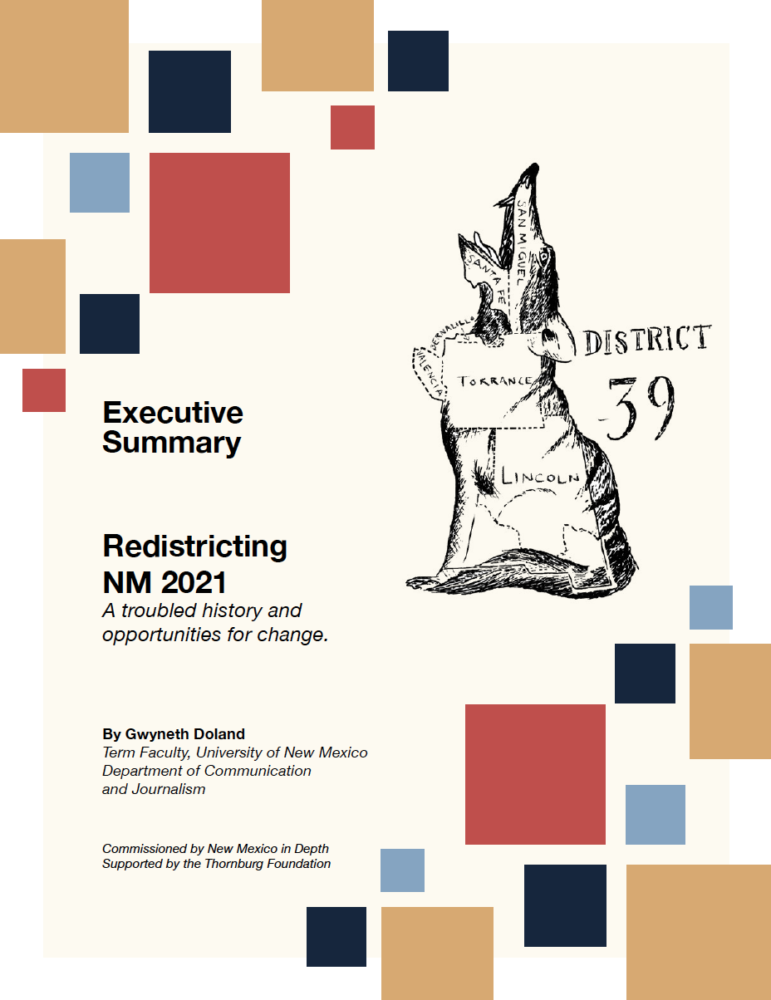
See that howling coyote? We hired a local artist to draw this critter as a nod to the political cartoon Elkanah Tisdale drew in 1812, skewering Massachusetts’ then-governor, Elbridge Gerry, who had signed a redistricting bill designed to strengthen his party’s grip in the state Senate. More than 200 years later, Tisdale’s sketch of a menacing salamander remains the iconic image of a practice we didn’t have a name for until he penned it: gerrymandering.
But state Senate District 39 looks more like a coyote than a salamander. It’s a creature that represents another aspect of what happens when sitting lawmakers draw their own districts. This patchwork district was pieced together out of scraps left after incumbents divided the rest of New Mexico among themselves the last time redistricting occurred, in 2011. Stitching the northern edge of Ruidoso to a string of small communities that reach all the way to Mora, lawmakers created a district some 300 miles miles long. Some folks who live in District 39 aren’t happy about it.
“The Republicans in Lincoln County have made it clear that they don’t want to be in the same district with the northern counties,” says Sen. Liz Stefanics, a Democrat who has represented the area since 2017. Stefanics also served in the Senate in the 1990s, but in those years she didn’t have to drive four hours south to talk to constituents in Lincoln County—it wasn’t part of the district.
Every 10 years New Mexico state lawmakers are assigned the task of redrawing district lines on the map for the Legislature (as well as the U.S. House and other offices), based on population changes recorded by the U.S. Census Bureau. But there aren’t many rules to govern the process, and it’s done largely out of the public eye.
As redistricting draws near, I took a look at how redistricting has worked here since the 1800s, and how our system compares to those used by other states. My report for New Mexico In Depth describes a history of abuse and identifies structural weaknesses that allow personal and partisan motives to distort the process.
In 2021, when New Mexico embarks on its next redistricting process, the Democratic Party will control both the Legislature and the governor’s office for the first time since the 1990s. They can be expected to approach the coming task with an eye on their own reelection and maintaining the advantage they have in the Roundhouse.
Some Republicans say that single-party rule gives Democrats the ability to design districts they know they can win, and will ensure Democratic majorities in the Legislature for the next decade. “They’re going to take advantage of their position and make themselves reasonably close to veto-proof — and they’re going to do it because they can,” says former state Sen. Rod Adair, a Republican from Roswell.
But Speaker of the House Brian Egolf, a Santa Fe Democrat, says guiding principles will drive the process.
“A lot of progressive thought on this issue starts with the presumption that legislatively driven reapportionment is bad because [nationally] Republicans have been doing it to our detriment for many years,” says Egolf. “But if you start with the guiding principles of protecting communities of interest, protecting racial and ethnic minority voting strength, creating districts that are compact — that don’t stretch 300 miles and look like an Octopus — then everything else seems to fall in place on its own.”
Experts disagree that everything will naturally, and fairly, fall into place, however.
In New Mexico, state legislators are relatively unencumbered by rules concerning redistricting, and because of, or in spite of, that liberty, the state has rarely accomplished the task without struggle, chaos, litigation and great cost to taxpayers.
From the report: Redistricting NM 2021
Compared to other states, New Mexico has relatively few constraints that would counter the conflict of interest inherent in having elected officials draw their own districts. “New Mexico has slightly more rules than Nevada, which is the state with the fewest,” says Justin Levitt, a professor at Loyola Law School who has done extensive research on redistricting. “There are other states that have behaved far more badly in the past, at least with respect to race and redistricting, … but the current conditions don’t provide a very strong form of resistance if legislators decide they want to abuse the system in 2021.”
In the past, the process of redrawing districts and reallocating seats has been closely followed by politicians, noted by journalists and community groups, but hardly noticed by the general public. This lack of public oversight has allowed lawmakers to proceed largely unencumbered.
Not so this time, some say. Oriana Sandoval, CEO of the Center for Civic Policy and a committee chair with iCountNM, the state’s census outreach organization, says her group plans to engage New Mexicans in the process and soon. Staff members are learning how to help members of the public make their own maps and planning to present them to lawmakers.
“When incumbents are charged with drawing these maps and there’s not an engaged electorate or an independent body to review them, then what’s to stop self-interest from being part of the equation?” Sandoval says.
Good-government groups including the League of Women Voters and Common Cause New Mexico have been advocating for years to move the redistricting process to an independent commission.
Lawmakers have rejected the proposals repeatedly. Like many elected officials, Egolf says redistricting is an inherently political process. That perspective was affirmed earlier this year by the U.S. Supreme Court, which ruled that how states structure their redistricting process is up to them.
To those in his own party who demand reform Egolf says: “If I’m running for the Legislature and my goal is to have clean air and clean water, increase education spending by 20 percent and protect a woman’s right to choose, and it’s easier for me to do that when the Democrats are in the majority, then why would I make it harder for the Democrats to win?”
The history of redistricting in New Mexico is one marked by neglect, brutal power struggles, long court battles and surprisingly high costs passed on to the taxpayers. All of these problems come back to the same issue: the conflict of interest inherent in having lawmakers draw their own districts.
More than 15 states will approach redistricting in 2021 with independent commissions in control of some element of the process. Others have tightened the criteria by which lawmakers must operate. Stefanics says at the very least communities bound together in a district need to have some commonalities. “I don’t have an easy answer, but I do think there could be some independent eyes on this.” She has pledged to work with the League of Women Voters on a bill to reform the process.
Most reform advocates, including the Brennan Center for Justice, say some form of independent commission is the best option for redistricting, but it’s not the only one. In October, the National Conference of State Legislatures released a report comparing New Mexico to other states with a wide variety of intermediate solutions. If it isn’t possible to have a commission, adding binding criteria can make the process fairer, Levitt says, arguing that the first one states should look at is a ban on favoring or disfavoring one party or one candidate. Putting that into law would mean if members of the public see partisan interference or a map drawn to favor the incumbent, they can sue to force changes.
“You don’t have to get it perfect to get it better,” Levitt says. “I’m firmly of the opinion that there is no one, right, true answer.”
Redistricting NM 2021 by Sylvia Ulloa on Scribd
